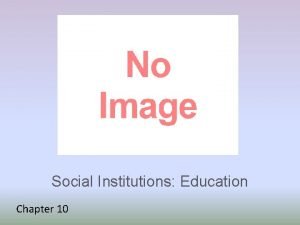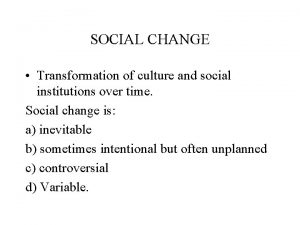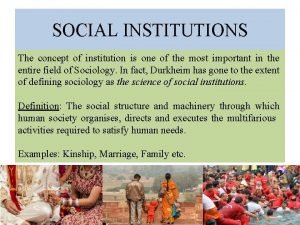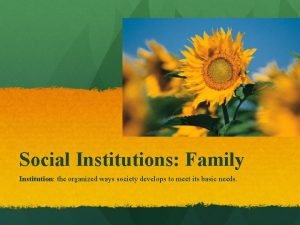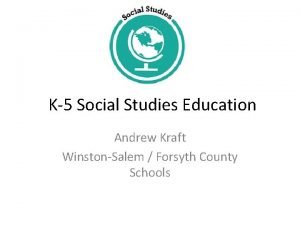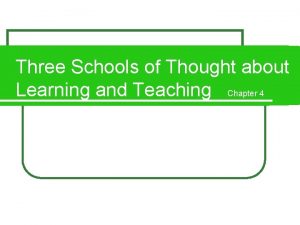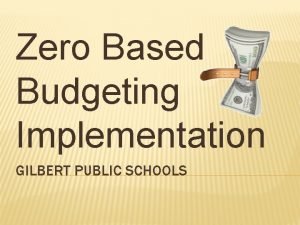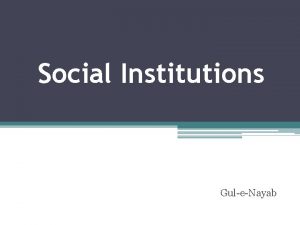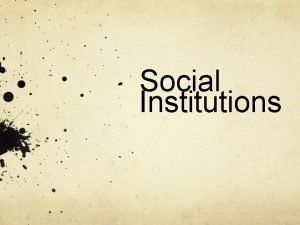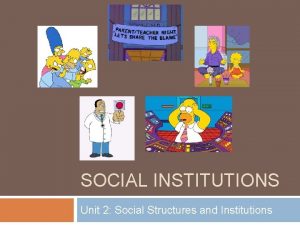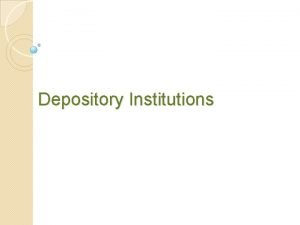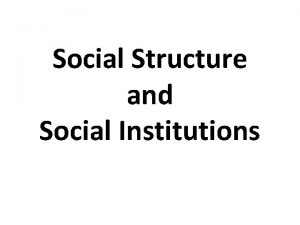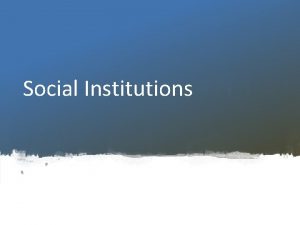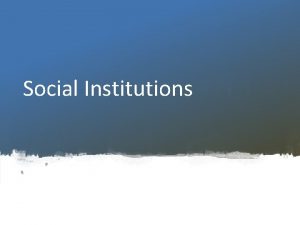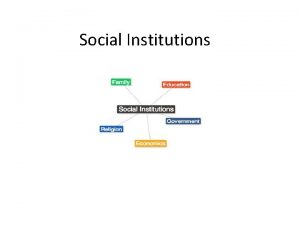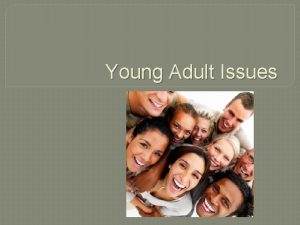Social Institutions Education History of Schools and Education












- Slides: 12

Social Institutions: “Education”

History of Schools and Education A. Original Purpose and Ancient Cultures: 1. Enculturation 2. Socialization B. Pre-Literate Societies: 1. Taught orally & by imitation 2. Taught by family & the community C. Literate Societies: 1. Taught literacy and basic skills

D. In America: 1. Schools created to = teach children to read the Bible 2. Constitution does not state education - falls to responsibility of the states (Article X) 3. Society changes from agrarian to industrial - education (high schools, common school & 3 R’s, women educators) 4. European ideas - kindergarten & Montessori schools - ideas of respect, patience, understanding vs. strict 5. American School Systems Develop - 1 st Kindergarten (1855) - 1 st High schools (1821) - 1 st Junior High (1910) - 1 st Middle Schools (1960)

Global Issues Affecting Schools 1. Low-Income Countries = too little/not enough schooling 2. High-Income Countries = unequal schooling 3. Illiteracy - 8 million of the world’s adults are illiterate (UNESCO Institute for Stats, 2006) 4. Gender disparity - most child labor is performed by girls (U. N. Development Programme, 1999)

Issues Affecting American Schools 1. School Funding - income taxes, property taxes, lottery, sales taxes…… what’s the answer? 2. Gender and Racial Inequality in schools 3 - Latinos score 200 pts and African-Americans score 300 pts below average white student on SAT’s (College Board, 2006) Immigration and it’s impact - In school districts in California there are over 100 languages spoken (Mitchell et a. , 1999) 4. Special Education and it’s impact - 7 million students w/ dissabilites enrolled in public schools costing $20 billion (U. S. Dept. of Education, 2006) 5. Teacher Shortage - 2 million teachers will be needed in the coming decade (National Education Association, 2006)

6. Emphasis on standardized tests - No Child Left Behind, 2001 7. School Violence 8. Drop Out Rates 9. Charter Schools & Home Schools, vs. Public/Private Schools

Theoretical Perspectives Theoretical Perspective Explanation: Application: Functionalist Perspective Conflict Perspective Symbolic Interactionalism Schools meet one or Relationship more of society’s basic between schools needs (tracking progress) and society are not always equal Schools transmit culture through socialization (values, norms, beliefs, attitudes) Manifest Function: - Transmit Culture - Common Identity - Promote personal growth & devlpmnt vs. Latent Function: - Dating/Marriage - Training Athletes - Prevent Delinquency Hidden Curriculum: nonacademic items taught by schools (discipline, conformity, order, cooperation) Teachers and Student Performance Meritocracy provides ALL an EQUAL chance for all to succeed but……. Inequality exists within schools! (gender, race, ethnicity, wealth, opportunity)

Types of Curriculum Traditional Curriculum: predetermined teacher-centered subject based classroom which emphasizes: reading, writing, and arithmetic VS. Integrative Curriculum: curriculum developed by student-teacher collaboration which is centered around real-world themes and ideas and varies

Structure of Education “The Traditional Model” A. Bureaucratic Model: schools are specialized to take large amount of students into age-based classrooms learn the same instruction from specialized educators. 1. emphasizes rules, procedures, standardized tests) 2. Based on the idea of Formal Schooling (education that is provided and regulated by society)

B. Progressive Movement: studentcentered education that emphasizes knowledge related to work and individual student interests 1. created by John Dewey in 1950’s 2. removes restrictions and allows student role in education C. Open Classroom Model: noncompetitive form that is flexible where students of various skill and age levels can learn together 1. popular in 1970’s 2. non-standardized curriculum 3. does not use grade-based reports D. Cooperative Learning Model: informal classroom structure where students are actively involved with others 1. Teacher is guide and NOT controlling agent 2. Replaces competition with cooperation “New Approaches”

Types of Schools Public School: an elementary or secondary school in the United States supported by public funds and providing free education for children of a community or district

Alternatives: Voucher System: certificate issued by the government which parents can apply toward tuition at a private school rather than at the public school to which their child is assigned For-Profit Schools: Charter Schools: A school that is A public school supported by public operated funds but run by independently of the private profit seeking local school board, companies often with a curriculum and educational philosophy different from the other schools in the system
 Hidden curriculum in education
Hidden curriculum in education Safety vs target vs reach
Safety vs target vs reach Transformation of culture and social institutions over time
Transformation of culture and social institutions over time Huntsville.powerschool
Huntsville.powerschool Social institutions
Social institutions The family is a social institution that is found in
The family is a social institution that is found in Social thinking and social influence in psychology
Social thinking and social influence in psychology Social thinking social influence social relations
Social thinking social influence social relations Wsfcs social studies
Wsfcs social studies What are the three school of thought
What are the three school of thought Gilbert public schools special education
Gilbert public schools special education Why study financial institutions
Why study financial institutions Financial intermediaries ppt
Financial intermediaries ppt
